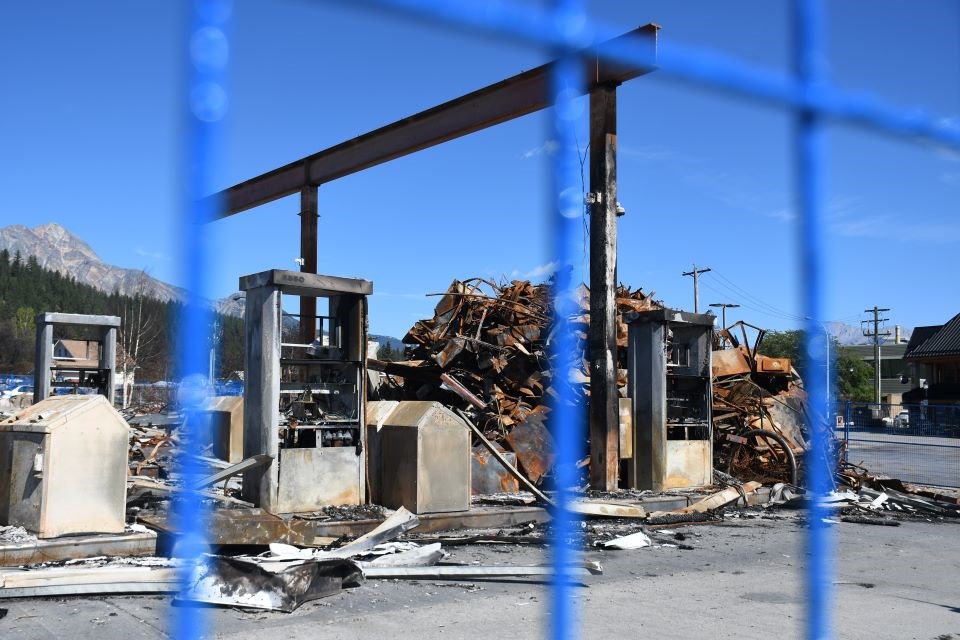The wildfire that destroyed a third of the Jasper townsite and national park is now considered the costliest disaster in Canada’s national park history.
The Jasper wildfire has resulted in $880 million in insured damages, according to a preliminary estimate from the Insurance Bureau of Canada (IBC).
“This is just the insurance damages for the homes, businesses and vehicles,” said Rob de Pruis, the bureau’s national director of consumer and industry relations, in a presentation to Jasper municipal council on Tuesday (Aug. 27).
“This does not include the wildfire response costs or the Parks Canada costs because they're provided funding under a different program for those. This is just the insured damages.”
The wildfires destroyed 358 structures within the townsite, including 820 residential units.
The Municipality of Jasper lost $283 million in assessed value for property taxes, but de Pruis clarified the $880 million figure included other damages.
“This is for the damages to not only the destroyed homes but the standing homes, the contents, additional living expenses, mass evacuation expenses, business interruption and also the personal and commercial vehicles that were damaged or destroyed,” he said.
The Jasper wildfire currently ranks No. 9 in Canada’s top 10 natural disasters for insurance payouts, according to the IBC.
The top three are the 2016 Fort McMurray wildfire at $4.5 billion, the 1998 Eastern Ontario ice storm at $2.6 billion and the 2013 southern Alberta floods at $2 billion.
Eight of the costliest disasters in Canadian history have happened since 2013.
De Pruis noted other recent disasters – such as the Montreal flooding, Ontario flooding or Calgary hailstorm – may push the Jasper wildfire further down the list at the end of the year.
“But as of today, it's No. 9, and that is a big deal, and I can also validate that this event is the costliest event in Canada’s national park history for insured damages,” he said.
There have been around 2,500 insurance claims for the Jasper wildfire in July and August, according to early IBC estimates.
The Ontario flood had 25,000 claims, the Calgary hail had 35,000 claims and the Montreal flood had 70,000 claims.
Insurance industry response
De Pruis also detailed to council how the insurance industry has been responding to the Jasper wildfire.
The IBC is a non-profit industry liaison that helps coordinate the insurance industry during major disasters such as the Jasper wildfire.
The bureau has been embedded in the Incident Command Centre since July 25. It has established a presence at Jasper’s Re-entry Support Centre and coordinated with 15 insurance providers.
The insurance industry has collectively worked to collect and dispose of appliances, such as contaminated fridges and freezers, with more than 2,000 appliances collected in Jasper.
De Pruis said the appliances were being degassed at the Jasper Transfer Station and would soon be moved out of the national park.
The IBC is also co-ordinating a debris removal program. Insurers hired a cost consultant and project manager, EllisDon, which is soliciting local contractors to partner with.
Coun. Scott Wilson asked what the timeline would be for debris removal.
De Pruis replied contractors would begin clearing debris from commercial sites once the waste stream is finalized.
Optimistically, all debris will be clear from the townsite by Nov. 30, but the process may take until the end of December.
“We're hoping that we're going to have all of the debris cleared by the end of this calendar year, but we understand everyone’s desire for an expedited and effective process,” de Pruis said.
“So, we will get going as soon as we have the authorizations and the clearance, and we’re going to start to see that falling done, particularly on the commercial side earlier on and on the residential side once [Team] Rubicon Canada has completed their sifting program.”
Over 300 properties have signed up for the sifting program. Only Team Rubicon or insurance representatives are allowed to access fenced-off properties and shift through debris.
De Pruis warned Jasper residents may not hear back from their adjuster immediately since many major events were occurring across the country.
“If you don't get a call back in an hour, in a couple of days, you will get a callback, and they will be responding,” he said. “So, I just wanted to flag that we're doing our best, we will get back to people and that these claims are important.”




